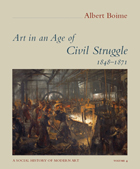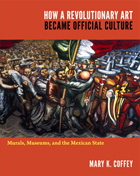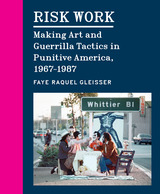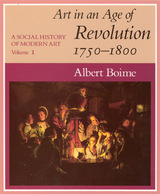4 books about Art and revolutions

Art in an Age of Civil Struggle, 1848-1871
Albert Boime
University of Chicago Press, 2008
From the European revolutions of 1848 through the Italian independence movement, the American Civil War, and the French Commune, the era Albert Boime explores in this fourth volume of his epic series was, in a word, transformative. The period, which gave rise to such luminaries as Karl Marx and Charles Darwin, was also characterized by civic upheaval, quantum leaps in science and technology, and the increasing secularization of intellectual pursuits and ordinary life. In a sweeping narrative that adds critical depth to a key epoch in modern art’s history, Art in an Age of Civil Struggle shows how this turbulent social environment served as an incubator for the mid-nineteenth century’s most important artists and writers.
Tracing the various movements of realism through the major metropolitan centers of Europe and America, Boime strikingly evokes the milieus that shaped the lives and works of Gustave Courbet, Edouard Manet, Émile Zola, Honoré Daumier, Walt Whitman, Abraham Lincoln, and the earliest photographers, among countless others. In doing so, he spearheads a powerful new way of reassessing how art emerges from the welter of cultural and political events and the artist’s struggle to interpret his surroundings. Boime supports this multifaceted approach with a wealth of illustrations and written sources that demonstrate the intimate links between visual culture and social change. Culminating at the transition to impressionism, Art in an Age of Civil Struggle makes historical sense of a movement that paved the way for avant-garde aesthetics and, more broadly, of how a particular style emerges at a particular moment.
Tracing the various movements of realism through the major metropolitan centers of Europe and America, Boime strikingly evokes the milieus that shaped the lives and works of Gustave Courbet, Edouard Manet, Émile Zola, Honoré Daumier, Walt Whitman, Abraham Lincoln, and the earliest photographers, among countless others. In doing so, he spearheads a powerful new way of reassessing how art emerges from the welter of cultural and political events and the artist’s struggle to interpret his surroundings. Boime supports this multifaceted approach with a wealth of illustrations and written sources that demonstrate the intimate links between visual culture and social change. Culminating at the transition to impressionism, Art in an Age of Civil Struggle makes historical sense of a movement that paved the way for avant-garde aesthetics and, more broadly, of how a particular style emerges at a particular moment.
[more]

How a Revolutionary Art Became Official Culture
Murals, Museums, and the Mexican State
Mary K. Coffey
Duke University Press, 2012
A public art movement initiated by the postrevolutionary state, Mexican muralism has long been admired for its depictions of popular struggle and social justice. Mary K. Coffey revises traditional accounts of Mexican muralism by describing how a radical art movement was transformed into official culture, ultimately becoming a tool of state propaganda. Analyzing the incorporation of mural art into Mexico's most important public museums—the Palace of Fine Arts, the National History Museum, and the National Anthropology Museum—Coffey illuminates the institutionalization of muralism and the political and aesthetic issues it raised. She focuses on the period between 1934, when José Clemente Orozco and Diego Rivera were commissioned to create murals in the Palace of Fine Arts, through the crisis of state authority in the 1960s. Coffey highlights a reciprocal relationship between Mexico's mural art and its museums. Muralism shaped exhibition practices, which affected the politics, aesthetics, and reception of mural art. Interpreting the iconography of Mexico's murals, she focuses on representations of mestizo identity, the preeminent symbol of postrevolutionary Mexico. Coffey argues that those gendered representations reveal a national culture project more invested in race and gender inequality than in race and class equality.
[more]

Risk Work
Making Art and Guerrilla Tactics in Punitive America, 1967–1987
Faye Raquel Gleisser
University of Chicago Press, 2023
How artists in the US starting in the 1960s came to use guerrilla tactics in performance and conceptual art, maneuvering policing, racism, and surveillance.
As US news covered anticolonialist resistance abroad and urban rebellions at home, and as politicians mobilized the perceived threat of “guerrilla warfare” to justify increased police presence nationwide, artists across the country began adopting guerrilla tactics in performance and conceptual art. Risk Work tells the story of how artists’ experimentation with physical and psychological interference from the late 1960s through the late 1980s reveals the complex and enduring relationship between contemporary art, state power, and policing.
Focusing on instances of arrest or potential arrest in art by Chris Burden, Adrian Piper, Jean Toche, Tehching Hsieh, Pope.L, the Guerrilla Girls, Asco, and PESTS, Faye Raquel Gleisser analyzes the gendered, sexualized, and racial politics of risk-taking that are overlooked in prevailing, white-centered narratives of American art. Drawing on art history and sociology as well as performance, prison, and Black studies, Gleisser argues that artists’ anticipation of state-sanctioned violence invokes the concept of “punitive literacy,” a collectively formed understanding of how to protect oneself and others in a carceral society.
As US news covered anticolonialist resistance abroad and urban rebellions at home, and as politicians mobilized the perceived threat of “guerrilla warfare” to justify increased police presence nationwide, artists across the country began adopting guerrilla tactics in performance and conceptual art. Risk Work tells the story of how artists’ experimentation with physical and psychological interference from the late 1960s through the late 1980s reveals the complex and enduring relationship between contemporary art, state power, and policing.
Focusing on instances of arrest or potential arrest in art by Chris Burden, Adrian Piper, Jean Toche, Tehching Hsieh, Pope.L, the Guerrilla Girls, Asco, and PESTS, Faye Raquel Gleisser analyzes the gendered, sexualized, and racial politics of risk-taking that are overlooked in prevailing, white-centered narratives of American art. Drawing on art history and sociology as well as performance, prison, and Black studies, Gleisser argues that artists’ anticipation of state-sanctioned violence invokes the concept of “punitive literacy,” a collectively formed understanding of how to protect oneself and others in a carceral society.
[more]

A Social History of Modern Art, Volume 1
Art in an Age of Revolution, 1750-1800
Albert Boime
University of Chicago Press, 1987
In A Social History of Modern Art, a sweeping multivolume social history of Western art from the French Revolution to World War I, Albert Boime moves beyond the concern with style and form that has traditionally characterized the study of art history and, in the tradition of Arnold Hauser, examines art in a broad historical context. Into his wide-ranging cultural inquiry Boime incorporates not only frequently studied mainstream artists and sculptors but also neglected and lesser known artists and unattributed popular imagery. He examines popular as well as official culture, the family as well as the state, and the conditions of the poor as well as of the affluent that affected cultural practice.
This inaugural volume explores the artistic repercussions of the major political and economic events of the latter half of the eighteenth century: the Seven Years' War, the French Revolution, and the English industrial revolution. Boime examines the prerevolutionary popularity of the rococo style and the emergence of the cult of antiquity that followed the Seven Years' War. He shows how the continual experiments of Jacques-Louis David and others with neoclassical symbols and themes in the latter part of the century actively contributed to the transformation of French and English politics. Boime's analyses reveal the complex relationship of art with a wide range of contemporary attitudes and conditions—technological innovation, social and political tensions, commercial expansion, and the growth of capitalism.
"Provocative and endlessly revealing."—Christopher Knight, Los Angeles Herald Examiner
This inaugural volume explores the artistic repercussions of the major political and economic events of the latter half of the eighteenth century: the Seven Years' War, the French Revolution, and the English industrial revolution. Boime examines the prerevolutionary popularity of the rococo style and the emergence of the cult of antiquity that followed the Seven Years' War. He shows how the continual experiments of Jacques-Louis David and others with neoclassical symbols and themes in the latter part of the century actively contributed to the transformation of French and English politics. Boime's analyses reveal the complex relationship of art with a wide range of contemporary attitudes and conditions—technological innovation, social and political tensions, commercial expansion, and the growth of capitalism.
"Provocative and endlessly revealing."—Christopher Knight, Los Angeles Herald Examiner
[more]
READERS
Browse our collection.
PUBLISHERS
See BiblioVault's publisher services.
STUDENT SERVICES
Files for college accessibility offices.
UChicago Accessibility Resources
home | accessibility | search | about | contact us
BiblioVault ® 2001 - 2024
The University of Chicago Press









